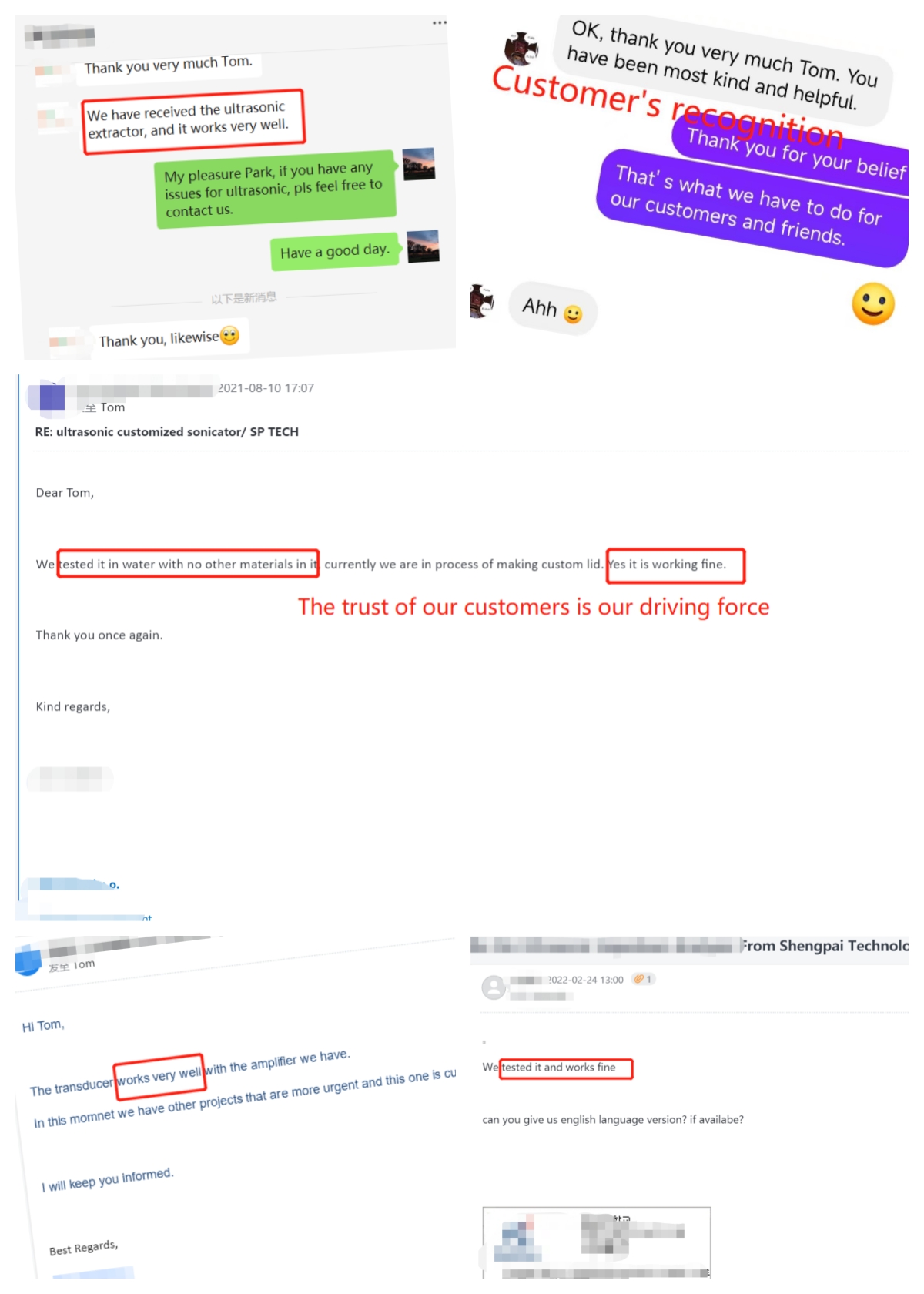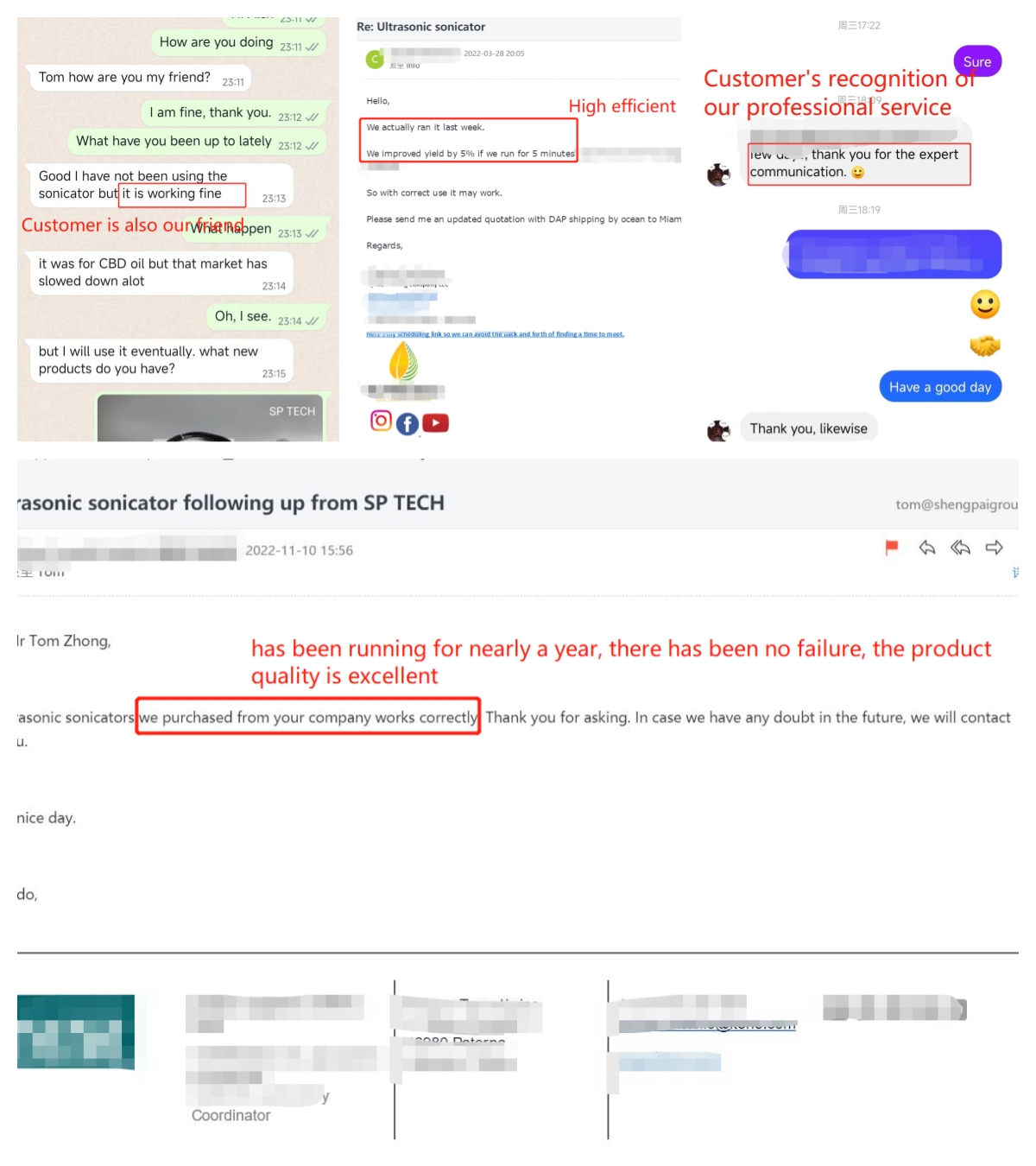| Availability: | |
|---|---|
| Quantity: | |
SPS20-1000/2000/3000
SP
8543709990
An ultrasonic sonicator is a laboratory instrument that uses high-frequency sound waves to disrupt and break open the cell walls of biologic al samples. This is a common technique used in molecular biology, biochemistry, and other fields to extract and isolate intracellular components such as proteins, DNA, and RNA.
al samples. This is a common technique used in molecular biology, biochemistry, and other fields to extract and isolate intracellular components such as proteins, DNA, and RNA.
The process of ultrasonic cell disruption involves applying high-frequency sound waves to a liquid sample containing cells. The sound waves cause the cells to vibrate rapidly, creating small cavitation bubbles that implode and generate shock waves. These shock waves cause the cell walls to break open, releasing the intracellular components into the surrounding liquid.
Ultrasonic sonication is a powerful and efficient method for cell disruption, as it is non-invasive and does not require the use of harsh chemicals or mechanical force. However, it is important to note that the intensity and duration of sonication must be carefully controlled to avoid damaging the intracellular components and altering their properties. Therefore, it is crucial to optimize the sonication parameters for each specific sample to ensure that the results are reproducible and accurate.
Model | SPS20-500S | SPS20-1000S | SPS20-1600S | SPS20-2000 | SPS20-3000 | SPS20-3000Z |
Frequency | 20Khz | 20Khz | 20Khz | 20Khz | 20Khz | 20Khz |
Power | 500 W | 1000 W | 1600 W | 2000W | 3000W | 3000 W |
Voltage | 220V | 220V | 220V | 220V | 220V | 220V |
Pressure | Normal | Normal | Normal | 35 MPa | 35 MPa | 35 MPa |
Intensity of sound | >10 W/cm² | >10 W/cm² | >10 W/cm² | >40 W/cm² | >60 W/cm² | >60 W/cm² |
Processing capacity (L/H) | 0.5-2.0 | 1.0-4.0 | 10.0 | 20.0 | 50.0 | 100.0 |
Material of probe | Titanium Alloy | Titanium Alloy | Titanium Alloy | Titanium Alloy | Titanium Alloy | Titanium Alloy |
Generator | Digital type | Digital type | Digital type | Digital type | Digital type | Digital type |
The application of ultrasonic sonicators for cell wall cracking is widespread in many fields of research, including molecular biology, biochemistry, microbiology, and biotechnology. Here are some examples of how ultrasonic sonicators are used in these fields:
1. DNA, RNA, and protein extraction: Ultrasonic sonication is commonly used to extract DNA, RNA, and proteins from cells. The process disrupts the cell walls, allowing the intracellular components to be released into the surrounding liquid, which can then be purified and analyzed.
2. Cell lysis: Ultrasonic sonication is used to lyse cells in order to release their contents. This is particularly useful for studying the properties of individual cells or for purifying cellular components.
3. Homogenization: Ultrasonic sonication is used to homogenize biological samples, such as tissues, to obtain a uniform mixture for downstream analysis.
4. Microbial disruption: Ultrasonic sonicators are used to disrupt and kill microorganisms, such as bacteria and yeast, in order to isolate their intracellular components or to sterilize equipment.
5. Nanoparticle synthesis: Ultrasonic sonicators are used in the synthesis of nanoparticles, such as gold nanoparticles, by breaking down larger particles into smaller ones.
In short, the application of ultrasonic sonicators for cell wall cracking has greatly facilitated research in many fields by enabling the efficient extraction and purification of intracellular components from biological samples.
1. Core parts with Titanium materials
2. Ultrasonic horn with different size and type for selection
3. Matching with digital generator, auto-tuning, auto search frequency
4. With automatic alarm protection, easy to operate
5. Power adjustable from 1% to 99%
6. Amplitude stability, long working hours, radiation area is increased 2.5 times than traditional tools
7. Provide consulting services and custom reactor designs
8. Custom sizes available for laboratory and high volume industrial applications.
Customers' evalution as follow:
The ultrasonic sonicator works very well.
We improved yield by 5% if we run for 5 minutes.
You have been most kind and helpful. Thank you for your expert communication.
Customers' recognition and trust is our driving force.
Shengpai Technology relies on “Customer Service Being First” as its corporate culture. Aim is ”Quality First, Service First”. Today, because of its abundant professional knowledge and good after-sales service, Shengpai Technology has gained a very good reputation.



An ultrasonic sonicator is a laboratory instrument that uses high-frequency sound waves to disrupt and break open the cell walls of biologic al samples. This is a common technique used in molecular biology, biochemistry, and other fields to extract and isolate intracellular components such as proteins, DNA, and RNA.
al samples. This is a common technique used in molecular biology, biochemistry, and other fields to extract and isolate intracellular components such as proteins, DNA, and RNA.
The process of ultrasonic cell disruption involves applying high-frequency sound waves to a liquid sample containing cells. The sound waves cause the cells to vibrate rapidly, creating small cavitation bubbles that implode and generate shock waves. These shock waves cause the cell walls to break open, releasing the intracellular components into the surrounding liquid.
Ultrasonic sonication is a powerful and efficient method for cell disruption, as it is non-invasive and does not require the use of harsh chemicals or mechanical force. However, it is important to note that the intensity and duration of sonication must be carefully controlled to avoid damaging the intracellular components and altering their properties. Therefore, it is crucial to optimize the sonication parameters for each specific sample to ensure that the results are reproducible and accurate.
Model | SPS20-500S | SPS20-1000S | SPS20-1600S | SPS20-2000 | SPS20-3000 | SPS20-3000Z |
Frequency | 20Khz | 20Khz | 20Khz | 20Khz | 20Khz | 20Khz |
Power | 500 W | 1000 W | 1600 W | 2000W | 3000W | 3000 W |
Voltage | 220V | 220V | 220V | 220V | 220V | 220V |
Pressure | Normal | Normal | Normal | 35 MPa | 35 MPa | 35 MPa |
Intensity of sound | >10 W/cm² | >10 W/cm² | >10 W/cm² | >40 W/cm² | >60 W/cm² | >60 W/cm² |
Processing capacity (L/H) | 0.5-2.0 | 1.0-4.0 | 10.0 | 20.0 | 50.0 | 100.0 |
Material of probe | Titanium Alloy | Titanium Alloy | Titanium Alloy | Titanium Alloy | Titanium Alloy | Titanium Alloy |
Generator | Digital type | Digital type | Digital type | Digital type | Digital type | Digital type |
The application of ultrasonic sonicators for cell wall cracking is widespread in many fields of research, including molecular biology, biochemistry, microbiology, and biotechnology. Here are some examples of how ultrasonic sonicators are used in these fields:
1. DNA, RNA, and protein extraction: Ultrasonic sonication is commonly used to extract DNA, RNA, and proteins from cells. The process disrupts the cell walls, allowing the intracellular components to be released into the surrounding liquid, which can then be purified and analyzed.
2. Cell lysis: Ultrasonic sonication is used to lyse cells in order to release their contents. This is particularly useful for studying the properties of individual cells or for purifying cellular components.
3. Homogenization: Ultrasonic sonication is used to homogenize biological samples, such as tissues, to obtain a uniform mixture for downstream analysis.
4. Microbial disruption: Ultrasonic sonicators are used to disrupt and kill microorganisms, such as bacteria and yeast, in order to isolate their intracellular components or to sterilize equipment.
5. Nanoparticle synthesis: Ultrasonic sonicators are used in the synthesis of nanoparticles, such as gold nanoparticles, by breaking down larger particles into smaller ones.
In short, the application of ultrasonic sonicators for cell wall cracking has greatly facilitated research in many fields by enabling the efficient extraction and purification of intracellular components from biological samples.
1. Core parts with Titanium materials
2. Ultrasonic horn with different size and type for selection
3. Matching with digital generator, auto-tuning, auto search frequency
4. With automatic alarm protection, easy to operate
5. Power adjustable from 1% to 99%
6. Amplitude stability, long working hours, radiation area is increased 2.5 times than traditional tools
7. Provide consulting services and custom reactor designs
8. Custom sizes available for laboratory and high volume industrial applications.
Customers' evalution as follow:
The ultrasonic sonicator works very well.
We improved yield by 5% if we run for 5 minutes.
You have been most kind and helpful. Thank you for your expert communication.
Customers' recognition and trust is our driving force.
Shengpai Technology relies on “Customer Service Being First” as its corporate culture. Aim is ”Quality First, Service First”. Today, because of its abundant professional knowledge and good after-sales service, Shengpai Technology has gained a very good reputation.



Address: No.30 DATANG VILLAGE FUYANG DISTRICT HANGZHOU CITY ZHEJIANG PROVINCE CHINA
Email: info@shengpaigroup.com
Tel: 0086-571-63127797
Mobile: 0086-15888033040
0086-15355441892

NEWSLETTER
Signup to be the first to know about discounts and new product releases.
